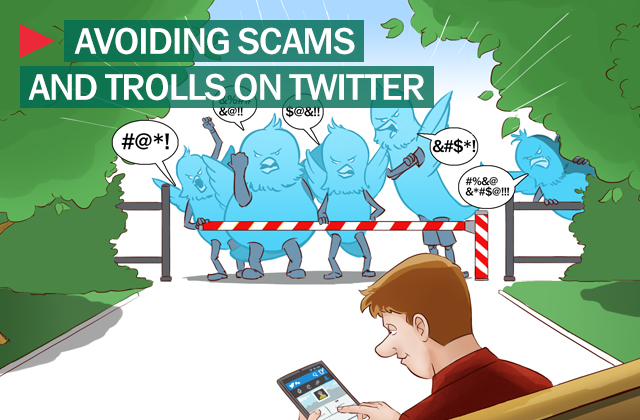Not long ago, Twitter was a novelty social media site that average users thought was silly. Now the microblogging tool is a vital news source and publishing platform, letting anyone share information and opinions from almost anywhere. Almost everyone is on it now, from your favorite celebrity to your parents.
But as is the case with every emergent trend on the Internet, Twitter is also populated by scammers and so-called ‘trolls,’ people who harass and provoke others with posts that range from the annoying to the profane. And what’s more, that security risk is essentially built into Twitter — its public-facing nature allows anyone to follow or mention anyone else, meaning users have little control over who can read their tweets, or tweets about them. Specifically blocking individual users is the only ingrained privacy protection. Avoiding the pitfalls of Twitter is critical to critical to keeping your devices and your identity safe and secure.
- Know how and when to ‘block.’ Whether they are bullies or spammers, sooner or later you’re going to end up with unwanted and potentially malicious followers. Periodically scroll through your list of followers and — on Twitter’s native platform — use the dropdown box next to the ‘follow/following’ icon, you can select block to prevent them from seeing your updates. If these users are clearly creating malicious or otherwise suspicious content, you can use the same drop down box to report them for spam. The sooner you block spammers, the better, to prevent them from sending spam to others.
- Twitter Client Tips. If you’re a regular Twitter user, chances are you use one of the numerous Twitter clients that optimize its native platform with multiple streams and additional built-in tools, particularly on mobile devices. Tweetcaster and Plume are the two most popular for Android; tweeTRO, Rowi and FlipToast are popular for Windows 8. Tweetdeck was among the most popular clients particularly for iOS, but the mobile app has been discontinued (including for Android). In its stead, Tweetbot, Janetter Pro and Osfoora are the most popular Twitter clients in iOS app store. Depending on which client you use, blocking/reporting spam for users will be different; some will be readily apparent, some will allow you to block and report in a single click, while others you have to hunt a little bit to find these features.
- Don’t get hacked. Trolls and attackers love to hack Twitter accounts (just ask any of the numerous high-profile users whose handles have been compromised), so it’s critical to keep your account safe. Using strong passwords is essential: They should be long, should not be names or words found in the dictionary, and should include non-alphanumeric symbols. Twitter recently introduced two-factor authentication, a significant boost to security for any online account, and while this can make signing in a longer process, that’s a small price to pay for keeping your account safe.
- Beware trending topics. Twitter created the concept of ‘trending’ topics, and hashtags are the Twitter medium for labeling content to increase its popularity. But beware, because whether it’s the latest celebrity buzz or a major tragedy in the news, the line between trolling and scamming can blur when these trending topics are hijacked by Twitter users who tease to content that masquerades as relevant to the trending topic, but instead includes a link that leads to offensive or harmful web pages. Trolls are particularly effective at doing this because their posts during sensitive times inflame readers —tweets mocking victims of school shootings, for instance — and by outraging people can entice them to click through to bad content.
- Don’t trust URL shorteners. Related to the trending topic warning, trolls and scammers use URL shorteners like bit.ly because they disguise the ultimate endpoint of the shortened link. If a tweet has a shortened URL and isn’t coming from a reputable source, don’t click through — if it’s legitimate content, you’ll see it elsewhere on Twitter and be able to read it there.
- Don’t share personal information. This really shouldn’t need to be said — and yet it does. People have shot themselves in their own feet on Twitter by posting personal information like their addresses and phone numbers, and there is even a handle devoted to people who have shared pictures of their debit and credit cards on Twitter. Because it apparently needs to be said, let’s say it here: Sharing personal information with millions of strangers risks your personal safety and makes you a target for identity theft, so never, ever tweet personal information.
- Don’t use public Wi-Fi. Don’t use other people’s computers, or public computers, to access personal accounts including Twitter. And don’t trust public Wi-Fi networks to access your accounts either; because public networks are rarely encrypted, attackers prey on their users to steal passwords and other personal data.
Following these seven tips is critical to keeping your personal data safe and secure, but its important to always have a backup for your system and device security. Security suites like Kaspersky PURE 3.0 defend against the latest malware and Internet threats and include password managers that help you handle your long, hard-to-hack passwords.
 online protection
online protection


 Tips
Tips